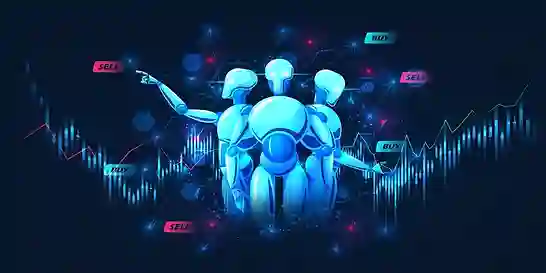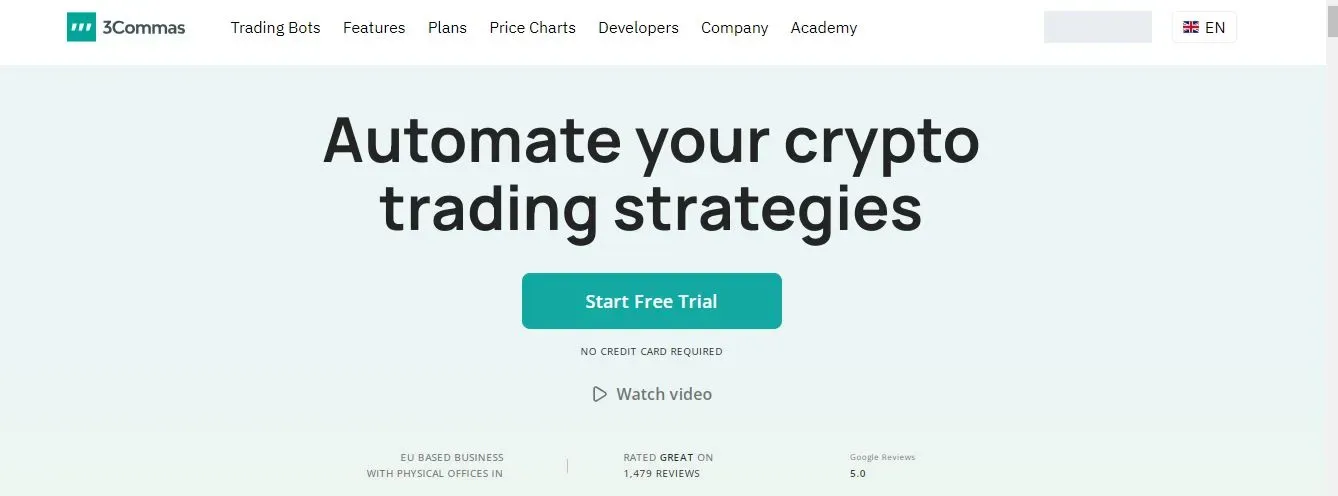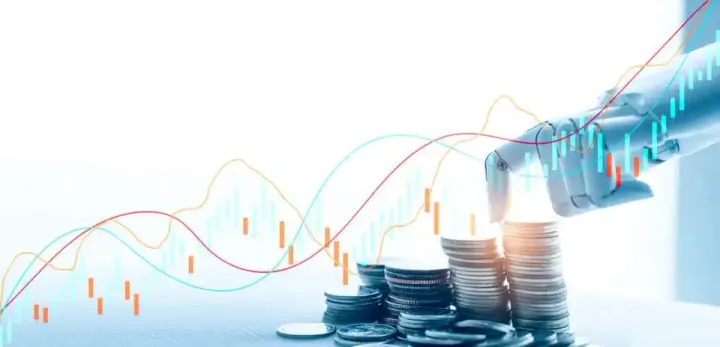AI Trading Bots: The Next Generation of High-Frequency Trading
AI trading bots are reforming the financial market by automating trading decisions. This software utilizes AI to analyze trading prospects and execute trades automatically. This article explores the aids and challenges linked to Algorithmic trading bots and their impact on the future of finance.

Getting a notification on your phone one morning that your investment has hit a new high is not something you imagine; it becomes a reality by relying on AI trading bots. These complex formulas are changing the financial industry, allowing people to earn money without waking up for it.
AI trading bots also referred as algorithmic trading bots, are computer applications that uses the power of artificial intelligence to regulate the best time to buy and sell assets in the market. They use innovative expertise and approaches such as AI and machine learning to come up with results that do not include human emotions, which most of the time affect traders.
Considering the growing market of algorithmic trading bots shows that the market has witnessed significant growth in recent years. According to the Fortune Business Insights report 2024, the total algo trading market is estimated to raise from USD 2.36 billion in 2024 to USD 4.06 billion by 2032. A CAGR of 7% was revealed during the forecast period. Moreover, in the US the AI trading market size is estimated to reach the maximum level of $1,042.8 million by 2032 due to its implementation in financial institutions. So, traders are discovering ways through the bots to develop effective strategies to make informed trading decisions. This article explores all the functionalities of AI trading bots, their working, benefits, challenges, and the prospects these bots hold for the investment industry. Let’s explore!
What are AI Trading Bots and how they are trained?
Trading bots also known as algo bots are AI-powered automated programs. The trading bots are developed on the fixed rules and data set by the brokers/traders. By following the data and rules, AI-powered trading bots effectively accomplish trades in several financial markets as traders or individual investors.
Moreover, at the very primary level, AI trading bots follow three pre-set rules which are as follows.
- Entry rule: It guides about when to sell and buy supplies/commodities.
- Exit rule: This rule directs the attention of the trading bot to when to close the current position.
- Position sizing rule: It hints about the amount or quantity to sell or buy.
Training AI Trading Bots
Training the AI trading bot involves serving it with the market’s historical database along with the use of AI in defining current patterns to avoid bad trades. Having been trained using labeled data or in some instances, the bot is allowed to train itself using unlabelled data under the unsupervised learning model. Additionally, the trading bots follow completely computerized algorithmic trading approaches irrespective of the involvement of any human biases. These bots have the following capabilities;
- Trading bots are designed with a powerful approach that helps trigger trading signals. By depending on on the signals, AI trading bots directly place orders in several brokerage markets or cryptocurrency markets.
- The algo bots guzzle a large amount of current and historical data which consists of news or social media feeds and other applicable data aiding the bots to execute precise data analysis.
- These bots are proficient enough to perform basic risk management and monitoring.
- Trading bots are also capable of keeping track of important positions of accounts such as usual prices, units, and other essential details.
How AI Trading Bots Work
AI trading bots typically follow a multi-step process:
1. Data Gathering: They obtain real-time data from exchanges, news feeds, economic indicators and volumes as well as from financial databases.
2. Data Investigation and Strategy Development: Collecting information from different platforms is not enough. The bots apply the most sophisticated algorithms to analyze the data collected and to find trends, patterns, and correlations. Moreover, strategy development is the essential pillar of any AI trading bot. The strategy is established through quantitative analysis and machine learning techniques. While designing the strategy, the following approaches are considered:
- Technical Analysis – In this approach, various price charts and indicators are analyzed. Indicators include Moving Averages (MA), Relative Strength Index (RSI), and Moving Average Convergence Divergence (MACD). Remember, in trading when MACD intersects RSI, then most of the AI trading bots make trade. Additionally, several patterns are also analysed in this section to predict future price actions.
- Sentimental Analysis – It includes the analysis of various news feeds and social media sentiments to measure the moods of the market to make the trade.
- Machine Learning Models – While strategizing AI trading bots, various AI models like reinforcement learning, neural networks, or regression analysis are used to make certain predictions according to historical data patterns.
- Statistical Arbitrage – It includes the identification and exploitation of disorganizations in prices between interrelated assets.
3. Signal Generation and Decision-Making: After developing the strategy, the trading bots start producing trading signals. The bots draw the signals whether to trade an asset or not, or whether to buy, sell or even hold an asset for a specific period by examining the conventional data. For example, if any of the models make predictions about the rise of stock price, the bot will immediately generate a “buy signal”.
4. Trade Execution: Once a decision is made, the bot directly opens a position through an application programming interface link to the brokerage platform. The execution algorithms ensure the trade carrying at ideal prices and slight slippage. The finishing process is of very high speed allowing the bots to make the most of all those chances that might be only accessible for milliseconds.
5. Monitoring and Reporting: AI trading bots continuously monitor their performance based on profit and loss, risk exposures, and effectiveness of strategies. Developers with the help of detailed reports note the insights which help in fine-tuning the strategies of bots further. So, this kind of AI-driven approach to trading makes the trades highly effective in today's fast-based financial markets.
Benefits of Trading With AI Robots
- Increased Efficiency: AI trading robots can efficiently perform trades on behalf of the user; such tasks can cut out much of the human error due to their automated nature. Additionally, these bots enable the faster execution of the trading process by performing repetitive tasks at scale, thus increasing efficiency. On a broader scale, algorithmic trading is dominating the trading world by accounting for 60-75% of total trading volume in Asian capital markets, the US equity market, and European financial markets.
- Improved Decision-Making: Since AI systems can process patterns in vast data, traders can make better decisions faster than through manual analysis.
- 24/7 Trading: AI trading bots can constantly trade 24/7, ensuring to seize every chance to make a trade.
- Risk Management: These bots can also be used to handle risks as containment measures including,
1. Position Sizing: The position sizing strategy helps in balancing risks and rewards across the trades. Based on the availability of funds, it commands the provision of capital to individual trades. Additionally, position sizing makes sure that any of the signal trade is not affecting the trade disproportionally. So, basically, this strategy is developed to allocate the right amount of energy and resources to all tasks, hence preventing overexertion.
2. Stop-Loss Orders: Stop-loss order closes a position automatically when it touches a specific price point. It helps bind the potential losses before the price drops further. By doing so, the emotional biases in making any trade decision are less or near to removal. Furthermore, stop-loss orders also help in preventing possible small leaks from major ruptures.
3. Take Profits Orders: AI trading bots are trained to set take profit orders to automatically lock the profit when a trade reaches a good and favorable price level. Training a bot in terms of taking profit orders ensures that amidst market fluctuations, profits are secured and the gains are locked before any mind change game of market.
Additionally, there are risk management algorithms as well. They are designed to assess the risk-reward ratio of each trade. By doing so, the algorithms ensure that the bots are operating within predefined risk parameters.
- Emotional Detachment: Algorithms trading bots are not known to act based on prejudices such as fear and greed as observed with human beings hence have a better way of making rational and biased decisions on trades.
- Backtesting Capabilities: These capabilities are equipped with functions that enable users to practice historical data to discover weaknesses inherent in strategies.
Types of AI Trading Bots
- Algorithmic Trading Bots: All these bots work on a strict basis where they contain a set of rules and strategies on how to trade. For instance, a basic crossover system can show a purchase signal when an analytical moving average short-term crosses the longer-term analytical moving average. Moreover, this kind of bot follows pre-determined rules to perform trades based on quantitative models, fundamental analysis, or technical indicators. The use case for algorithmic trading includes mean reversion, trend following, and event-grade trading.
- High-Frequency Trading (HFT) Bots: Meant to carry out a lot of trades in a short period, HFT bots take advantage of discrepancies in price of as little as the spin of the planet. The use case for HFT includes arbitrage, market making, and statistical arbitrage.
- Arbitrage Trading Bots: These bots aim to make money by buying and selling an asset in one market and immediately reaping the benefits in another market. For instance; if the price in a given stock on one exchange is relatively higher than in another, an arbitrage bot shall purchase in the cheaper market and sell in the costlier market. The use case for Arbitrage trading includes the identification and capitalization of arbitrage opportunities in stocks or currencies.
- Predictive Trading Bots: Predictive trading bots employ the aspect of machine learning to estimate based on various parameters such as past trends of the market.
Key Factors Considered for Trading
When making trade decisions, AI trading bots consider a variety of factors, including:
- Technical Indicators: In this regard, relative moving averages (MA), relative strength index (RSI), Bollinger Bands, and other upward/sideways indicators would enable one to determine areas of trends, momentum, and reversal.
- Fundamental Analysis: Information that can help in the decision-making includes earnings, economic conditions, and other news influences that regard to particular industry or business.
- Sentiment Analysis: The positive, negative, or neutral tone of social media discussions, the direction of news headlines, and any other textual data can all be used to predict existing market sentiment and likely price shifts.
- Market Cap: The market capitalization of an asset can tell a lot about its size and efficiency in the market.
- Volatility: The importance of volatility measurement can be recommended by the fact that it allows for evaluating the risk connected to an asset as well as used for making trading decisions.
- Correlation: Cohesion analysis of different assets shows the possibilities of diversification and possible risks.
- Risk Management: AI trading bots can be programmed with risk controls; entry, exit, stop loss, position size, and risk of ruin.
How can live data for AI trading bots be Obtained?
AI-based trading bots need feeds and those feeds establish a relationship with the stock exchange market. This data can be obtained from various sources, including:
- Exchanges: Binance, Coinbase, Kraken, and other large exchanges offer APIs that allow a developer to access both historical and live exchange data.
- Data Providers: Bloomberg, Refinitiv, and Alpha Vantage are some of the major specialized data providers online, which cover most of the Market Data including APIs as well.
- Open-Source Data: There are also many other sources of open data existing in the web resources, for instance, Yahoo Finance and Google Finance. From these data sources, the data can be obtained for AI trading bots.
So, by carefully selecting reliable data sources, users can gain important and relevant live data to train and operate AI trading bots efficiently.
Integration of AI Trading Bots in Capital Market Platforms
After learning has occurred, AI trading bots can easily be incorporated into the existing platforms of the capital market. While on some, it is possible to simply enable the option for a bot integration, on others it will be necessary to program such a feature. Popular platforms for AI trading bot integration include:
- Binance: Binance has a much more solid API and also allows clients to develop their style of bot.
- MetaTrader5: This popular platform also offers robust APIs for the development and integration of custom trading bots.
- TradingView: It Backtest and automate your strategies based on Artificial Intelligence on a cloud-based platform.
- Python: There are many trading bots developed with the Python language for the construction of AI. That decision means it provides a rich toolkit of libraries and tools in the areas of data analysis, machine learning, and back-testing.
Actual-life Applications of AI Trading Bots
- Quantitative Hedge Funds: Most quantitative hedge funds employ artificially intelligent trading bots to make their portfolio and perform trading operations concurrently.
- Retail Investors: Small investors can also try using AI trading bots to conduct their investments even with small amounts of capital.
- Forex Trading: It is known for buying and selling currencies. So Forex trading bots with the help of AI, analyze the market trends, identify the ongoing patterns, and execute the trades accordingly. Meta Trader is the popular platform that Forex trades use. It greatly helps in analyzing the market data, order placing, and managing the trading accounts. Daily turnover in the forex market for trading of currencies is about $6.6 trillion dollars and therefore the forex market is the biggest and most active market in the world. The most traded currency pairs in forex markets are EUR/USD, USD/JPY and USD/CHF.
- Cryptocurrency Trading: High-frequency trading using algorithmic programs has continuously made its way into the market of crypto due to high volatility. Due to the use of crypto AI trading bots the cryptocurrency market has experienced significant growth in recent years, resulting in a significant increase in the daily trading volume. The major cryptocurrencies include bitcoin, Binance Coin, and Ripple.
How to Select the Best AI Trading Bot?
When it comes to trading with AI trading bots, users need to select a trading bot that meets their aims and tolerances to risk. Here are some immediate factors to consider:
- Investment Goals and Risk Tolerance: The very first step while selecting any trading bot is to completely aware of your investment aims. Furthermore, users must have enough tolerance toward investment risks. After that one can find a bot that suits their passion.
- Bot Features: These include back-testing options, customizable bots, market real-time data streaming, and anything you may need in your trading.
- Reputation and Reviews: Find out more about the supplier of the bot, and their history, as well as other people’s experience with their product.
- Cost: To this end, there are costs involved in the use of this bot such as subscription fees and transaction costs.
- Ease of Use: Always choose a bot that offers good accessibility and reliable customer support. Furthermore, an easy-to-use bot can help make the trading process smooth.
Listing Some Best AI Crypto Trading Bots in the Market
Since the integration of AI in trading bots is becoming popular, there are countless AI-powered trading bots offering solutions for big financial firms or new-generation trading firms. Some popular bots include:
1. 3Commas

3Commas is a popular Crypto AI trading bot with an amazing user-friendly interface. Due to the availability of a variety of trading bots such as dollar-cost averaging (DCA), option bots, and grid trading, it is one of the best tools for both experienced and beginner traders.
If we talk about the standout features of 3Commas then it has a SmartTrade terminal feature. It allows the users to make the execution of trade with advanced order types and performance across multiple exchanges. Along with that, it also offers ultimate support with over 20 major exchanges. The exchanges include some big names like Binance, Gemini, Bitfinex, Kraken and Coinbase pro helps in flexibility and compatibility. Moreover, the users can also utilize the integration of TradingView for the creation of customized signals.
Pros
- 3Commas supports 20 plus crypto exchanges.
- It offers a free plan.
- Bot offers a bunch of both automated and manual trading options.
Cons
- Might be suspected of some security breaches.
- Free Plan: $0 per Month
- Pro Plan: $37 per Month
- Expert Plan: $59 per Month
- Custom Plan: Contact
Ratings
According to Trustpilot: it’s 4.3 Out of 05
2. Coinrule

It is a rule-based trading bot. Due to its rule-based feature, Coinrule is ideal for users who want to automate their strategies without coding. In terms of rules, the platform offers 250 sets of rules which can be customized on the basis of market conditions. Like all other AI trading bots, it also supports other exchanges to provide broad market access. Moreover, Coinrule offers a range of templates like;
- Buy the Dip
- Catch the Swing
- Uptrend Flash Crash
So Coinrule with its easy-to-use interface is best for the newbie traders to get a quick start.
Pros
- The bot consists of high-level security.
- Coinrule also offers customizable bot making.
- It consists of unlimited template strategies.
- It has a free version.
Cons
- Coinrule has a high straight cost.
- Starter Plan: Free
- Investor Plan: $29 per Month (billed yearly)
- Trader Plan: $59 per Month (billed yearly)
- Fund: $249 per Month (billed yearly)
Rating
According to Trustpilot: its 4.3 Out of 05
3. Cryptohopper

Cryptohopper is the most popular cloud-based AI crypto trading bot. Due to the bot's cloud-based nature, users don't need to keep their computers running for bot operation. Cryptohopper offers a range of features which include;
- Backtesting
- Strategy design
- Marketplaces (where the users have the authority to buy or sell the trading strategies).
As per supported exchanges are concerned the Cryptohopper trading bot supports 17 major exchanges including Binance, KuCoin, and Poloniex as popular ones, thus making the bot accessible to a wide user range. By using the platform's strategy builder feature, Cryptohopper offers a variety of customized trading strategies. Furthermore, it also offers social trading to help users follow and copy the marketing portfolios of top traders.
Pros
- It offers a custom bot-making feature.
- offers a free version.
- Users can get a 30% discount while entering/using the code "CLICKOUT."
- Cryptohopper also offers the availability of arbitrage and market-making bots
Cons
- Despite the free trial, the subscription plans are a bit expensive in terms of using multiple open positions.
- Pioneer Plan: Free
- Explorer Plan: $24.16 per Month
- Adventure Plan: $57.50 per Month
- Hero Plan: $107.50 per Month
Ratings
According to Trustpilot: Its 3.9 Out of 05
4. Pionex

Another Free AI trading bot and exchange is Pionex. Debuted in 2019, it aims to make automated trading available for everyone without any cost of money. Let’s talk about its features;
Pionex provides a collection of 16 trading bots. The bots have the capability of performing any operation without human intervention. One of the most popular bots amongst all is the Grid trading bot. It aims to make the buys low and sells high in a predefined price range. Another major integration includes a dollar-cost average bot which helps in investing a certain amount of money at regular intervals.
Moreover, the Pionex bot offers 350 trading pairs along with the provision of spot and futures trading. These pairs help in identifying smart and cheapest rates across multiple exchanges. As far as the support of exchanges is concerned, then Pionex is itself a crypto exchange. So it does not support any other crypto platform for API trading like Binance or OKX.
Pros
- It's all free.
- Pionex supports almost 380 cryptocurrencies .
- best platform for cryptocurrencies
Cons
- Pionex does not support traditional assets such as stocks.
Pricing
It’s all free to use. The platform charges a 0.05% trading fee per transaction.
Ratings
According to Trustpilot: Its 3.0 Out of 05.
5. Shrimpy

With a high focus on portfolio management and rebalancing, Shrimpy marks as a unique AI crypto trading bot. It performs operations like, automating portfolio strategy, backtest strategies, and performance monitoring. While having the feature of integration with exchanges like Binance, HTX, and Coinbase, Shrimpy ensures inclusive access to other multiple trading markets.
One of the primary strategies that Shrimpy holds is portfolio rebalancing. Users can set the allocations for the portfolios and the bots will take charge to maintain such allocations. This feature helps the traders to manage the risks and improves long-term performance.
Pros
- Easy to use.
- Price plans are pretty affordable.
- A free plan is also available.
- Shrimpy offers portfolio rebalancing and social trading as well.
Cons
- Shrimpy does not offer any crypto signals.
- Free Plan: 0 per Month
- Standard Plan: $15 per Month
- Plus Plan: $39 per Month
Ratings
According to Trustpilot: Its 3.1 Out of 05
Challenges and Limitations of AI-Powered Trading Robots
- Market Volatility: Social sentiment trading involving AI trading bots can be affected by unexpected market shocks that result in loss-making.
- Ethical Considerations: Another issue of a large-scale implementation of AI is that it can be leveraged for very questionable purposes, such as manipulative stock trading, or displacement of human workers.
- Technical Challenges: Using and especially maintaining artificial intelligence trading bots may be challenging from the technological perspective that often includes data science, machine learning, and programming.
Recent Developments in AI-Powered Trading Bots
- Machine Learning Advancements: Innovations in machine learning algorithms are providing new ground for AI-based trading bots to perform sophisticated tasks and changing market environments.
- Natural Language Processing (NLP): NLP is being applied to filter and understand market sentiment as well as news for trades that can improve or enhance the value of a trade.
- Blockchain Integration: When deciding on the application of AI trading bots, blockchain technology as their addition may provide advantages like security, transparency to the existing trading process, and efficiency.
AI-Powered Trading Bots: Future Forecast
AI trading bots are worth developing in the future, they even have more potential in the financial industry. Some key areas to watch include:
- Increased Efficiency and Accessibility: The use of AI trading bots may help improve investment results and increase the availability of the investment process for a larger number of people.
- Democratization of Financial Markets: Therefore, probably a democratic method of equal opportunities, AI trading bots can help subscale investors compete with large institutional investors.
- Ethical Considerations: It is going to remain important to deal with ethical issues that are linked with the use of AI in trading to make sure that AI trading will be developing as it should.
Conclusion
Automated trading with the help of AI is one of the most useful tools for investors who would like to increase their revenue and minimize their losses. These bots can offer a lot by doing their tasks autonomously, making decisions based on the input data, and functioning all the time. However, there is a need to exercise a lot of caution when considering the integration of the challenges and limitations of AI trading strategies.
So, as the technology develops, it will be possible to identify only new and more complex forms of AI trading bots. When aware of the advantages, drawbacks, and opportunities that AI trading holds, investors can then choose to enjoy the fruits of this fascinating innovation.

